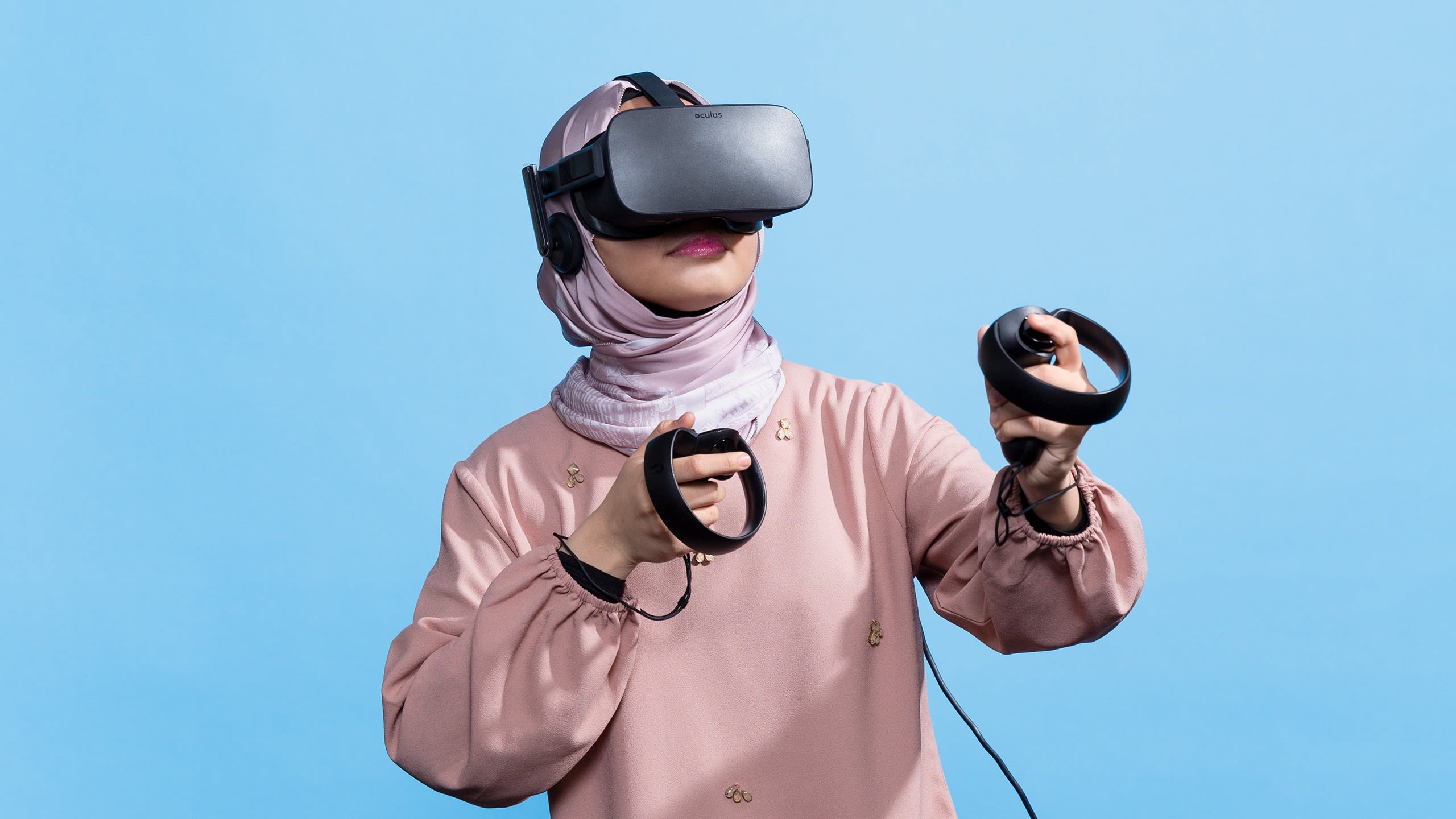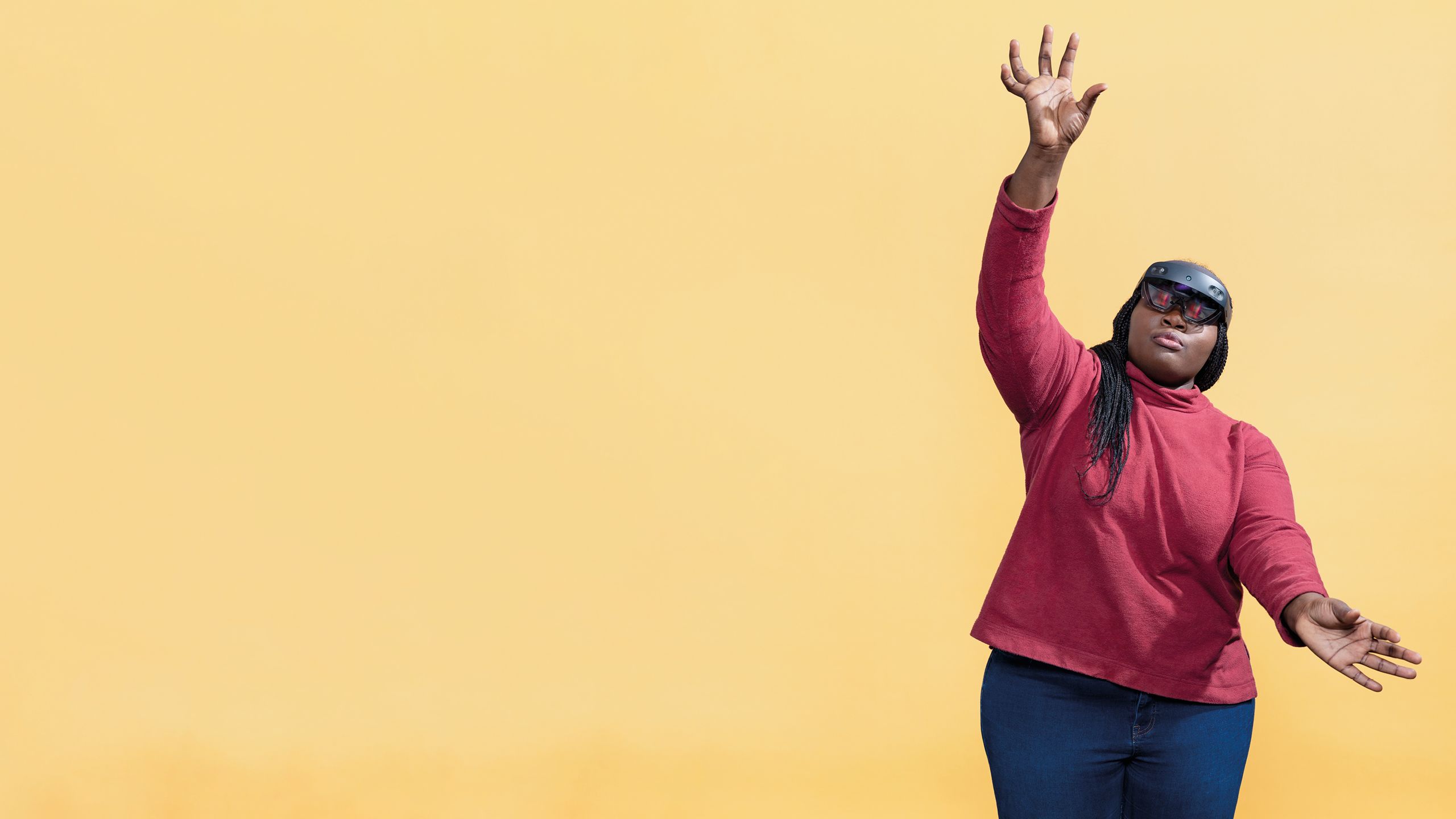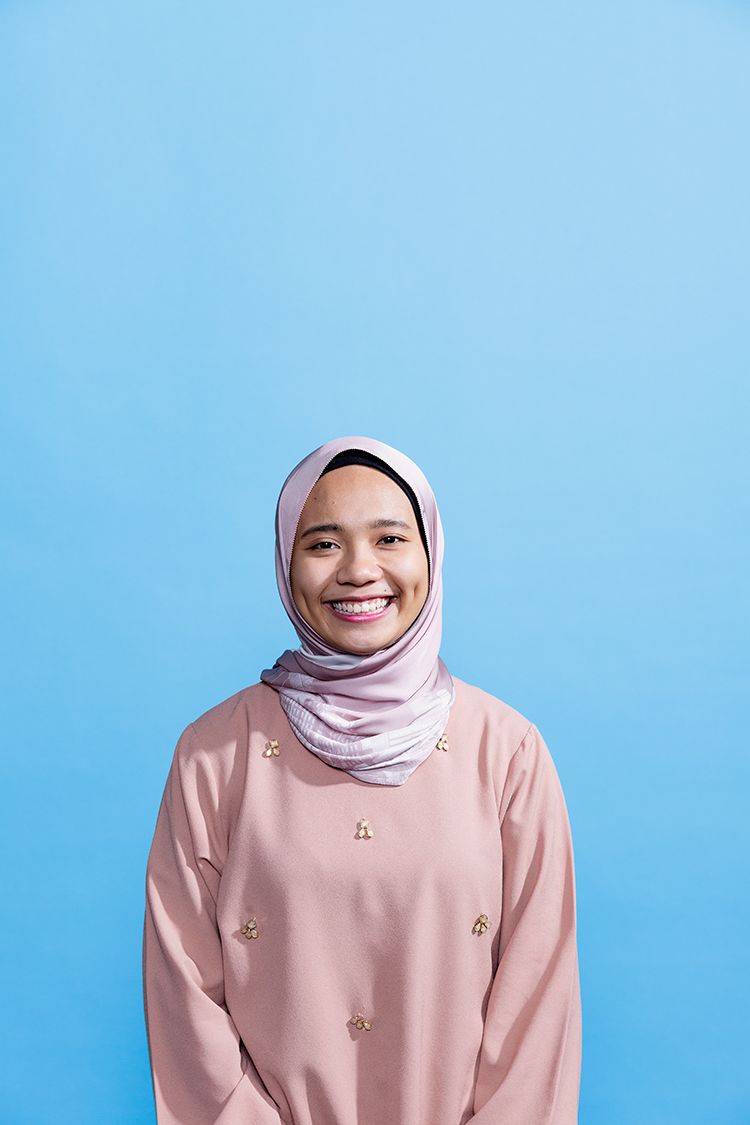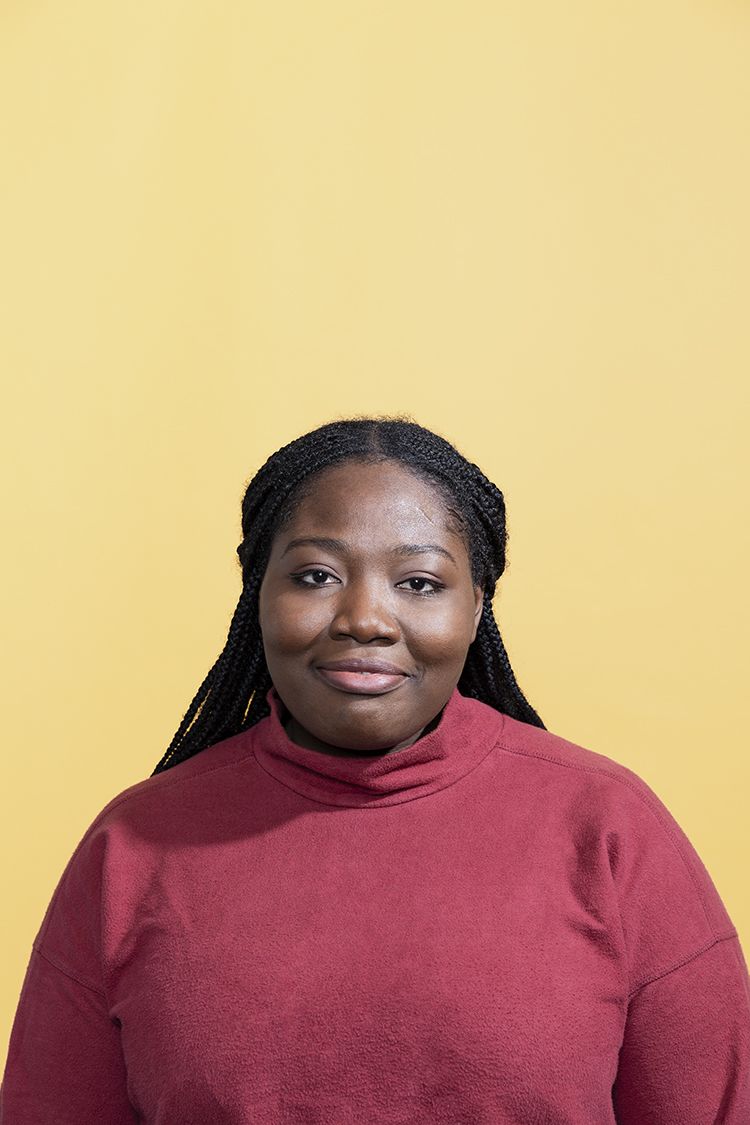Seeing is believing and believing is seeing
From hologram lectures to the gamification of pure maths, technology is transforming teaching at Imperial.

Field trips to Mars. Hologram lectures and virtual anatomy lessons. Fluid dynamics experienced in real time, from within the flow. It sounds like science fiction, but for Imperial students it is becoming their everyday reality, as the College leads the way in blending the classroom and the digital world.
“Hologram technology has a very long history at Imperial,” says Dr David Lefevre (MSc Computing 2002, PhD Management 2011), Director of the Edtech Lab at Imperial College Business School, “so when I read about a Canadian startup enabling holographic speakers, I immediately thought we could use that for education.
"We developed it and held our first event – a Women in Tech conference – in 2018 with holographic speakers, including Marily Nika (MSc Computing 2008, PhD 2014), Google’s Computer Programming Manager. The new technology means the speaker can maintain eye contact with the audience – wherever they are – and respond directly to questions.”
Blending teaching between digital and the classroom is all about finding the right medium for the right subject, says Dr Lefevre. “I never really liked the lecture theatre,” he says. “Talking to a wall of students, there’s very little interaction – it’s quite a passive experience for the students. I used to think, I might as well show a video of myself.
"In a lab, or in the discussions we have around business case studies, it’s different – it depends what you’re trying to teach. But when I started teaching online, I found I was having very meaningful interaction with the students – I would set a problem and they’d work through it and ask questions. My job became to guide them through the material."
This approach has worked particularly well for mathematics. “To do an MBA you need at least A-level maths, but our students come from a wide range of backgrounds, with vastly differing experiences.
"We used to bring them in early for a week of intensive maths, face-to-face, nine-to-five. It didn’t work. Now it’s online, they go at their own pace. They have to study 15 hours of material over three months. We employ teaching assistants to answer their questions and they can book in for a tutorial.
"From the data, we get a strong sense of who’s struggling, and we work with them one-to-one if we need to. We now have a 100 per cent pass rate – it’s solved a significant problem for the Business School. I got an email from a father saying, ‘That is the first maths test my son has ever passed!’”
If there’s a bubble rising you can travel around it, look at the flow field, hear the pressure, experience the liquid move
Omar Matar (MEng Chemical Engineering 1993), Vice-Dean of Education in the Faculty of Engineering and a Professor of Fluid Mechanics, is developing a deeper understanding of fluid mechanics and maths by using virtual reality. “Have you ever dived into a swimming pool?” he asks.
“We know how it feels and sounds, so watching someone else dive in just doesn’t compare.” Matar worked with a postdoctoral computer scientist to create 3D animations from equations and import them into a virtual environment.
“We then created a platform where you could load different flows and then dive right in! If there’s a bubble rising you can travel around it, look at the flow field, hear the pressure, experience how the liquid moves.”
Students were, understandably, very excited. “It takes a few sessions to get used to it – some people get motion sickness! But we soon had people from all over the College hanging around the lab wanting to try it. There was a feeling of disbelief. Students said it didn’t feel like ‘education’, it felt like a games arcade.”
Matar and his team learned the gaming software language, Unity, to link the programme to learning outcomes.
“So, you get points to unlock levels, and there is positive competition between players. You get sucked into the game and then find yourself doing more and more pure maths and equations. We’re squeezing in the learning.”
Mixed reality
As New Media and Innovation Lead at the Digital Learning Hub, Thomas Hurkxkens tests immersive technologies such as virtual and augmented reality and supports teachers in using these technologies for teaching and learning. Using smartglasses such as a HoloLens, for example, means medical students can study the anatomy of the human body in 3D and in motion, including carrying out a virtual biopsy.
Using the real and virtual needle together, the students can perform a biopsy, without the need for a CT scanner
“A HoloLens is a good example of the strength of immersive technologies,” says Hurkxkens. “It’s a mixed reality, where students can work with the digital object and the real-world object at the same time.
"In the case of the biopsy application, students see a virtual torso and needle, projected over a real-world body-phantom. Using the real and virtual needle together, they can perform a biopsy without the need of a CT scanner. This gives students and trainees more time to practise when and where they want, and we expect that this gives a deeper, embodied understanding of the procedure. It’s learning by doing.”
Students can also use the HoloLens to project skin conditions on to each other’s bodies, he says, which means they can examine each other, bringing social interaction into the learning experience. Medical and Chemistry students alike can get a 3D view of a molecule. And Earth Science and Engineering students can go on field trips… to Mars!
“Together with Professor Sanjeev Gupta and team, we are designing a project where we use data from the Mars Rover,” Hurkxkens says, “so students can explore the planet’s surface together.”
The use of these technologies in education is growing, but there are still many areas that need further exploration. At the Digital Learning Hub, for instance, the aim is to bring students, researchers and partners together to build on each other’s expertise through things such as the Immersive Technologies Initiative, a web portal for students and teachers and partners to connect, learn and exchange ideas.

Experimental classroom
These technological possibilities mean there’s a learning curve for teachers, of course, and even a change in the nature of teaching.
“Teaching becomes less of an individual activity and more about co-creation, where teachers work with developers and even students to develop courses,” says Gideon Shimshon, Director of Imperial’s Digital Learning Hub.
“One teacher said that she was surprised that, in the experimental classroom, there is no screen or lectern, so instead of using a PowerPoint presentation she had told a story and asked students to draw it – with better results than the traditional approach. It can lead to different kinds of teaching.”
Digital tools can also scale up learning and make it available far beyond the physical classroom. “Online, we can give a lecture to 10,000, instead of 500,” says Shimshon. “And with open content, we have hundreds of thousands of people taking our online courses.
"We are mission-driven at Imperial: we want to contribute to the global challenges of lack of access to education and healthcare. We have an online A-level maths course that is free, so anyone can do it. On our online Public Health Master’s programme, students are in 24 different countries – we’re building a global public health community.”
Shimshon says not everything is scalable, though, and his team is still exploring the limits. “A book is scalable,” he explains, “but the classroom experience of guiding you through the book, giving feedback and assessing, isn’t. With tech, we are merging the classroom and the book. Continuous assessment is the best kind, and tools for this would free up teachers for better teaching and research.
“People like Dr Amir Sam, Head of the Undergraduate School of Medicine, are developing multiple-choice questions to a state-of-the-art level that will really test learning in healthcare. But how you test learning is the subject of scholarly work itself. We do need to be able to prove these new techniques work – we’re training doctors here!”
Matar has a plan to prove it, and to go a step further. He and his colleagues are beginning to collect data through specialised VR headsets equipped with eye-trackers and EEG electrode caps that could make teaching and learning a completely bespoke experience. “Through the headsets we can see what the students see,” he explains.
“With eye trackers, we see where they look, and we can track how they perform in VR. If we can link what they are seeing with their neural activity, through brain-computer interfaces such as EEGs, we can correlate behaviour with cognition. Then, with AI and machine learning, we can make content adjustments on the fly. So, the teaching would be tailored to the way the student learns.” Matar and his team are going for a proof of concept this year.
Watch this space – through your headset.
What our students say
Aiman Binti-Ahmad-Dzulfakhar
Studying: MEng Chemical Engineering, third year.
What equipment: VR headset to explore fluid mechanics.
The experience: Incredible! I could experience the conditions of the fluid, such as pressure and speed, by being in the fluid virtually and not just seeing it in 2D. It's learning on another level.
Ayomide Ayorinde
Studying: Medicine, fifth year.
What equipment: Augmented reality smartglasses to explore a segment of a human spine model.
The experience: Once you really get into it you can easily get lost in the awesomeness of it all. Being able to view the model from all the different planes was very, very cool, and I definitely wish I had had access to it in my earlier years of medical school.
Imperial is the magazine for the Imperial community. It delivers expert comment, insight and context from – and on – the College’s engineers, mathematicians, scientists, medics, coders and leaders, as well as stories about student life and alumni experiences.
This story was published originally in Imperial 48/Summer 2020.


